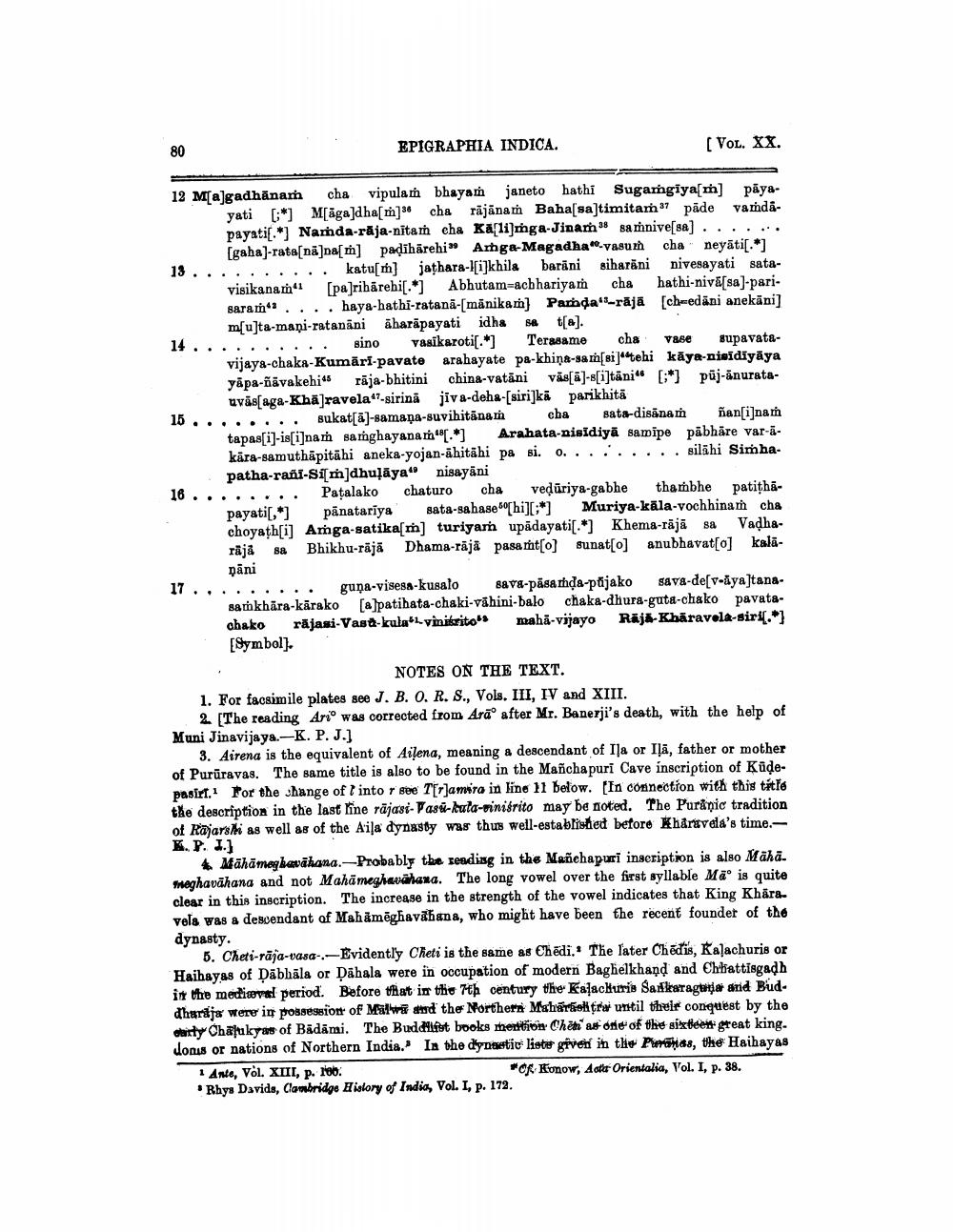________________
EPIGRAPHIA INDICA.
(Vol. XX.
14..
.
.
.
.
12 M[a]gadhänam cha vipulam bhayam janeto hathi Sugamgiya[m] paya
yati [*] M[äga]dha[m]* cha rājānam Baha[sa]timitam7 pädevamdapayatif.*] Namda-rāja-nitam eha Kā[li]mga-Jinam" samnive[sa]. .....
[gaha)-rata[nā]n[m] padībārehi* Amga-Magadha"-vasum cha" neyāti[.*] 13 .......... katu[m] jathara-1[i]khila barani siharani nivesayati sata
visikanam" (pa]ribārebis.*) Abhutam=acbhariyam cha hathi-nivā(sa)-parisara".... haya-hathi-ratanā [mānikam] Parda-rājā [ch-edāni anekāni] m[u]ta-mani-ratanini äharāpayati idha s t []. ........ sino v asikaroti[.* Terasame cha Vase supavatavijaya-chaka-Kumāri-pavate arahayate pa-khiņa-sam[si]"tebi kāya-nisidiyāya yapa-sävakehi rāja-bhitini china-vatāni vās[a]-s[i]täni" [*] püj-anurata
uvās[aga-Khajravela"-sirina jiva-deha-(siri]kä parikhita 15 ........ sukat[@]-samaņa-suvihitānań cha sata-disanam ñan[i]nam
tapas[i]-is[i]nam samghayanam"[.*] Arahata-nisidiyā samipe pābhäre var-ākāra-samuthäpitähi aneka-yojan-āhitāhi pa si. 0......... silähi Simha
patha-rani-Si[m]dhulāya" nisayani 16 ........ Patalako chaturo cha vedūriya-gabhe thambhe patitha
payatis,*) pânatariya sata-sa hase[hi];*) Muriya-kāla-vochhinam cha choyath[i] Amga-satika[m] turiyam upadayati(.*) Khema-rājā sa Vadharāja sa Bhikhu-rājā Dhama-rājā pasamt[o] sunat[o] anubhavat[0] kala
pāni
....... guna-visesa-kusalo sava-påsarhda-păjako SAVA-de[v-iya]tanasamkhāra-kārako [a]patihata-chaki-vähini-balo chaka-dhura-guta-chako pavatachako rājasi-Vasa-kula'h vinirito" mahā-vijayo Räja-Khäravela-siris.*] [Symbol].
NOTES ON THE TEXT. 1. For facsimile plates see J. B. O.R.S., Vols. III, IV and XIII.
2. The reading Ario was corrected from Arão after Mr. Banerji's death, with the help of Muni Jinavijaya.-K. P. J.)
3. Airena is the equivalent of Ailena, meaning a descendant of Ila or Iļā, father or mother of Pururavas. The same title is also to be found in the Mañchapuri Cave inscription of Kūdepasirt. For the change of l into r see T[r]amara in line 11 below. (In connection with this titre tše description in the last line rājasi-Pasi-kula-vinisrito may be noted. The Puranic tradition of Rajars i as well as of the Aila dynasty was thus well-established before khårivela's time..P. J.]
Māhā mekavāhana.-Probably the reading in the Mañchapuri inscription is also Mäha. meghavāhana and not Mahāmeghaváhana. The long vowel over the first syllable Mão is quite clear in this inscription. The increase in the strength of the vowel indicates that King Kháravels was a descendant of Mahămēghav hana, who might have been the recent founder of the dynasty.
6. Cheti-rāja-vasa-.--Evidently Cheti is the same as Chēdi.. The later Chedis, Kalachuris or Haibayas of Dābhāla or Dāhala were in occupation of modern Baghelkhand and Chhattisgadh in the medieval period. Before that in the 7th century the Kalachuria Salkaragtitia and Bud(harija were in possession of Malwisud the Northern Maharãokiţra until their conquest by the derty Chalukya of Bädami. The Buddhist books mention Chëti' as one of the sixteert great king. Jonus or nations of Northern India. In the dynastic liste given in the Peronas, the Haihayag 1 Ante, Vol. XIII, p. 100.
of Konow, Acts Orientalia, Vol. I, p. 38. Rhys Davids, Cambridge History of India, Vol. I, p. 172.




